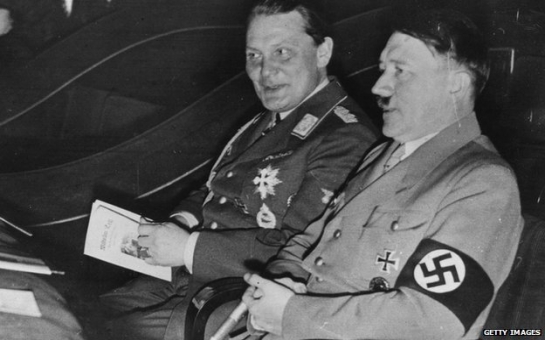She seems the gentlest of gentlewomen as she stands reflectively. Her skin is pale against the blackness of her dress. She holds a prayer book, indicating devout learning. Her other hand rests easily on a skull - the reminder of death. She exudes nobility.So how did this grand Welsh lady get to mix with bad Nazi company? The painting is now owned by the National Museum of Wales but during World War Two it was in the collection gathered by Hermann Goering, Hitler's deputy, head of the Luftwaffe and the man who founded the Gestapo.The subject of the painting is Catrin of Berain - or Katheryn to her English friends. For centuries the portrait hung in family homes near Denbigh in North Wales but somehow it was acquired by the Nazis.The story of how the painting went from Wales to Berlin and then back to the National Museum of Wales has been pieced together by experts keen to establish that there are no legitimate counter-claims to its ownership. Controversy invariably surrounds works of art accrued by the Nazis so the curators in Cardiff have made doubly sure that the portrait of a Welsh gentlewoman has a clean past.After all, there are currently fierce legal disputes over a collection of paintings discovered hidden in Munich, and over priceless artefacts from the medieval church - bought by the German state from Jewish art dealers in the 30s when the Nazis were in power - and now on display in a museum in Berlin.Looking at Catrin's life story, it's difficult to see why exactly a top Nazi might take an interest in her.According to Helen Williams-Ellis, who is writing a biography of Catrin, the noblewoman was born in 1540 in Berain near Denbigh in north-east Wales.Catrin's father was a land-owner, Tudur ap Robert, with a substantial 3,000 acres. At the age of 22, Catrin married one John Salusbury, the son of a neighbouring land owner. Money married money to keep money in the family.After nine years of marriage and two children, Catrin's first husband died. Williams-Ellis told the BBC that afterwards Catrin married another rich man, Sir Richard Clough, again, according to Helen Williams-Ellis, to keep money in the family.Clough, known by the Welsh as Rhisiart Clwch, was a merchant who divided his time between north Wales, London - where he was one of the founders of the Stock Exchange - and Antwerp. In what seems like a Welsh cliche, Clough had not been born to immense wealth but was noticed for his fine singing voice in the choir of Chester Cathedral and despatched to court in London. That opened the way to riches.In Antwerp, Catrin had her portrait painted and the picture was hung for more than two centuries in family homes in north Wales.In 1938, the owners decided, for reasons that haven't been established, to sell the picture and contacted a dealer in London. It was offered to the National Museum of Wales but, somehow, the sale failed to happen.The London dealer had connections with the art market in Amsterdam and in November, 1940 the painting was bought by Walter Andreas Hofer, the adviser on art to Hermann Goering.It seems incongruous that the founder of the Gestapo should be an art collector but he was building up a collection to aggrandise the Reich.In 1945, with the Reich in ruins a mere 12 years into its existence, the portrait was rediscovered by the victorious Allies and documented. Special units, soon to be depicted in the movie The Monuments Men, rescued works and then traced their route to the Nazi collection - the circumstances in which they were acquired, who originally owned them.In the case of the portrait of Catrin, they tracked down the Dutch dealer who originally had sold it and returned the painting to him. It is for this reason that the National Museum of Wales is confident there can be no dispute over ownership. The man who sold it got his work back.Why did the Nazis want the painting of a Welsh noblewoman? Oliver Fairclough, the Keeper of Art at the National Museum of Wales, said the Nazis accrued works to aggrandise themselves and their regime."A lot of it was 'art as power and status'," Fairclough says. They wanted to display the best of traditional art.It seems the regime wanted the picture because it was a Flemish masterwork rather than for its subject. It was probably painted by Adriaen van Cronenburgh who produced portraits of merchants in the commercial hub that was 16th Century Antwerp.Nonetheless, Fairclough is intrigued by what he calls a "fascinating" picture."She is very well dressed," he says. "She's wearing black which was a very expensive cloth because it had to be dyed. There's a gold chain around her neck and pearls in her head dress".Despite the seriousness of the portrait, there is a scintilla of a hint of a smile if you want to see one. It is nice to imagine that she was not straight-laced. In all, she married four times and had six children by three husbands.Williams-Ellis wonders if she is pregnant in the picture because rich women of the era occasionally had their portraits painted before childbirth, which increased the family's consciousness of mortality.Catrin divided her life between the deep countryside of north Wales and the hubs of the new commercial world, Antwerp and London. It must have been a whirlwind of change as she moved between Denbighshire and these two bustling centres.Six years into their marriage, Sir Richard Clough died in Hamburg at the age of 40 - the second husband Catrin had lost. There is a theory that he was poisoned as a suspected spy for Queen Elizabeth I - Catrin's world was not boring and ordinary.Antwerp 16th CenturyShe then looked back to Wales and to property for her third husband, Maurice Wynn of Gwydir, the High Sheriff for Caernarfonshire. The cynical view - and also the view of Catrin's present-day fan, Williams-Ellis - is that marriage was, at least partly, about financial considerations. Catrin had another two children with her third husband. And then, he, too, died.So she married a fourth husband, who, finally, survived her.Catrin of Berain died on 27 August 1591. She is buried at the parish church in the village of Llanefydd near the farm where she was born and grew up.After her death, 13 elegies were written in praise of her - eight in Welsh, two in Latin and three in English.What about the man who had bought the portrait for Goering? Walter Andreas Hofer was "Director of the Reichsmarschall's Art Collection" from 1939 to 1944. After the war, a French military tribunal sentenced him in absentia to ten years in prison.Somehow, though, he never served that sentence and continued to work undisturbed as an art dealer in Munich, dying in an obscurity he no doubt welcomed in the early 70s.And what about the mysterious Catrin? It would be nice to think that she shudders from beyond the grave at the very thought of monstrous Goering once gazing on her kindly image.The story of Catrin o Berain can be seen at 20:30 GMT on Sunday on S4C as part of the series Mamwlad (Mother Country). You can also watch online at s4c.co.uk/clic. English subtitles are available.(BBC)ANN.Az
Mystery of the Nazi and the portrait of a Welsh lady
World
23:58 | 20.01.2014

Mystery of the Nazi and the portrait of a Welsh lady
A portrait of a 16th Century Welsh noblewoman was discovered in the art collection of leading Nazi Hermann Goering. What was it doing there?
Follow us !










